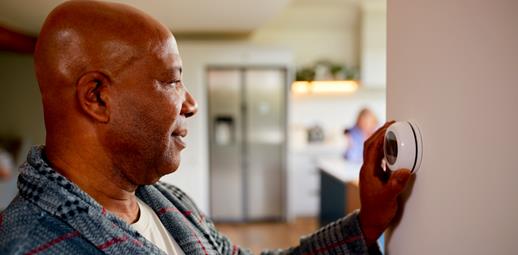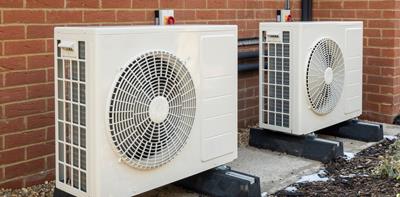
Energy bills are high, so when you use your central heating you’ll want to do so as cost-effectively as possible.
But is it better to have heating on low for longer? Or should you pump up the temperature in bursts?
This topic is a source of debate. But what do the experts say?
EASY AS HACK
Thermostatic Radiator Valves enable you to control each radiator – so you don’t pay for heat when you don’t need it.
At a glance
- Test the most economical way to use your central heating.
- Set your heating at the right level for each room in your house.
- Insulate your home.
- Make sure there are no draughts.
- Get your boiler serviced regularly.
The most economical way to use central heating
Whether it’s cheaper to have your heating on constant or timed is debated by experts. It can depend on things like the size of your house, how well insulated it is and many other factors.
Should you heat your home in timed bursts?
The Energy Saving Trust , an independent organisation that provides advice on energy use, is unequivocal on this point. It says that keeping your heating on all day uses more fuel and so is more costly.
Typically, the most energy-efficient approach is to use a central heating timer to make sure your home is heated when you need it.
Ideally, if you have room thermostats or a smart heating system, then you can begin to really take control of your usage. Using a smart heating system means you can set rooms or areas to heat up at certain times, and to specific temperatures.
You can also use Thermostatic Radiator Valves (TRVs) to help control the way you heat your home. They control the temperature of individual radiators, meaning you can switch off radiators in rooms you’re not using.
Is it better to have heating on low for longer?
On the other hand, some specialists argue that you should keep your boiler on a constant low setting, with your radiator valves on maximum. This is to prevent condensation forming in the fabric of your walls, which happens if your radiator frequently flips from hot to cold.
Having condensation in the walls is inefficient in terms of heating for two reasons.
Firstly, when the heating is switched on, it uses energy to evaporate the moisture. Secondly, having moisture in the walls makes them less effective as insulation. This is because heat can pass through more easily, rather than being trapped.
Having moisture in the walls can also cause mould to grow, which can be very hazardous to your health.
So, what’s the verdict?
The most accurate way to find out which approach works best for your home is to test it. If you have a smart meter, this will make the job easier.
You could spend one week having the heating on a constant low temperature, and the next heating the house in bursts. Obviously, the test will be fairer if the weather and outside temperature is more or less the same for both weeks. Take a meter reading at the beginning and end of each week and compare results. Then you’ll have a good idea which is the most energy-efficient approach for your home.
Whatever you decide to do, beware the risk of frozen pipes. If the outside temperature goes to 0°C or below, water in your pipes can freeze, which runs the risk of them bursting.
Read our tips on how to reduce the risks of your pipes freezing and bursting this winter.
How do you run central heating efficiently?
Set your room thermostat
Set the thermostat to make sure your room is only heated to a certain level. The heating will adjust to maintain the temperature you’ve set, rather than continuously heating up your house.
Use a timer or programmer
Control when your heating and hot water comes on and off. If you’re not at home most of the day, you can program your heating and hot water to come on just before you get home.
Use thermostatic radiator valves (TRVs)
Control the temperature of each individual radiator. The TRV can adjust the flow of hot water into each separate radiator, meaning you can turn specific radiators off if you don’t use the room they’re in.
Set your boiler thermostat
Set the temperature of the water pumped from the boiler through the radiators. You can control exactly how much your water heats up, and how warm your house gets.
Use smart heating controls
Track and make changes remotely to your heating. You can check on the temperature while you’re out and adjust it accordingly.
Regularly service your boiler
Servicing and maintaining your boiler will help it run more efficiently, costing you less in the long run.
How else can you heat your home cheaply?
Insulate to stop heat escaping
To make the most of that precious warmth, you need to stop it escaping. One of the major factors affecting your heating costs is insulation, so it’s a good place to make any improvements you can.
And if you’re thinking about selling your home, this is also among the most commonly recommended areas for improving your EPC rating.
If your home has a loft, about 25% of the heat will be lost through the roof. In a semi-detached house with an uninsulated loft, buying and installing insulation should cost you from £880 to £1,200, depending on your type of home, according to The Energy Saving Trust.
You could also consider insulating the walls, if they aren’t already. For a cost of approximately £2,700, based on a semi-detached house, getting cavity wall insulation could reduce your bills by up to £235 a year.
If you have a very energy inefficient property, you may be eligible for a home insulation grant from the government’s Great British Insulation Scheme.
Block any draughts or leaks
Draughts and leaks can easily mess with how efficient your heating is, so make sure you block as many as possible.
Ensure your radiators are running efficiently
Make sure your radiators are at maximum efficiency by bleeding them regularly. Read our guide on how to bleed your radiators.
Invest in thick curtains and keep them shut
Thick curtains will help insulate your home and will also help block any drafts from your windows.
Close doors to keep the heat in one room
If you’ve got rooms you don’t really use, keep the doors closed so the heat only circulates in the rooms you’re actively using.
Ensure your radiators aren’t blocked
Make sure you don’t have any large pieces of furniture in front of your radiators as that will prevent the heat from circulating the room.
Use electric heating efficiently
You may not have a gas central heating system. For example, if you live in a home with no mains gas connection, you may have electric heating.
Electricity can often be more expensive than gas, so make sure you’re using your electric heating as efficiently as possible. Some electric radiators will have systems like motion detection and open window detection and adjust themselves automatically to make your heating as efficient as possible.
You can also use the same tricks as you would for gas central heating, like only heating the rooms you use most often and setting your heating on a timer.
Heat yourself not the home
Some great advice if you can’t afford to turn on the heating is to heat the human, not the home. This means keeping you and your loved ones at home warm, even if your property remains cold. It’s an idea that has been made popular by money saving expert Martin Lewis.
His tips to stay warm at a low cost include using:
- Hot water bottles – when you sit down, try sitting in a sleeping bag with a hot water bottle in there.
- Electric blankets – and other plug-in options, like USB gloves, heated insoles or an electric heat pad.
- Slippers – particularly those that enclose your feet.
- Layered clothes - don't forget your thermal socks too
FAQs
What is the cheapest time to heat your home?
Local energy rates are lower during off-peak hours (usually overnight and early morning) although exact times vary depending on where you live and your energy supplier.
What is the best setting for central heating?
The lowest comfortable temperature is usually between 18-21 degrees Celsius.
Should you turn off radiators in unused rooms?
Turning off radiators in rooms you’re not using can help cut costs. But make sure you stop any draughts from coming into the rest of the house from that room. Keep the door shut and use a draught excluder if necessary.
For more useful household tips and advice, go to Solved.
You can find out more about our home insurance here.


